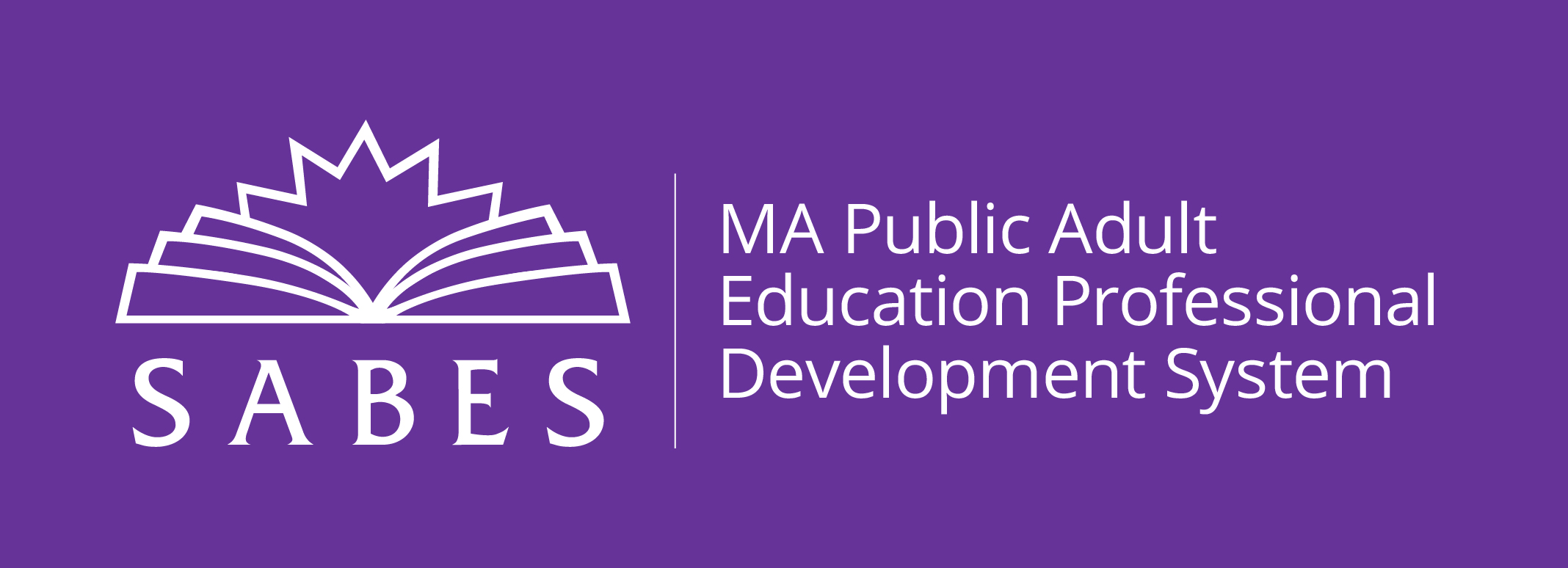When talking about inclusive practices, there are many acronyms: DEI, ADEI, EDI to name a few. Regardless of which you use, they all have one shared purpose: The dismantling of systemic barriers that virtually every one of our students face in the pursuit of equitable access to opportunity. But when we talk about “inclusion,” who exactly do we mean? Who do we want to “include”?
At the SABES Program Support PD Center (PSPDC), we recognize that changing our practices to be truly inclusive requires program-wide cooperation and collaboration. Diversity, Equity, and Inclusion is one of nine priorities that ACLS has asked the PSPDC to support, and we see tremendous synergies across this work with other PSPDC priorities, such as ADA (Americans with Disabilities Act), digital literacy, and advising. We have curated a list of practices, PD, and resources (included at the end of this article and in this PDF), to help you move this work forward with your staff, students, and partners.
Why do we prioritize this work?
Almost 70% of our students identify themselves as Black, African American, Hispanic, or Latinx. In order to support them, we must strive to better understand the lived experiences of our students of color, confront the discriminatory practice in our systems, and take action to ensure that all students have equitable access to the same services and opportunities that so many of us take for granted.
We must also recognize the complexity of “inclusion” by acknowledging that each person carries multiple identities, many of which are invisible. An awareness of how these identities intersect with power, privilege, and wealth—or lack thereof—form a critical basis of our work. Every day, adult educators see the impact of mental health issues and violence on our students and in our classrooms. How many people with physical disabilities are enrolled in our programs? Veterans? What are the unique needs of people re-entering our communities after a period of incarceration? Those who are living in temporary housing or shelters?
We know that race, poverty, and education are inextricably linked to health disparities that have created a public health crisis. While these conditions have long existed, those of us who work in adult education have had a front row seat to observe how the pandemic has exacerbated and highlighted this “great divide.”
Practices that lift all boats
When we use strategies to include some students, we end up benefiting all students, as understood and seen through the theory of Universal Design for Learning. This is because inclusive practices (like those listed below) are also effective teaching and advising practices, and have the effect of improving student learning outcomes. Additionally, students with invisible struggles or undisclosed learning differences benefit from the strategies put in place to accommodate their peers. Therefore, our DEI (Diversity, Equity and Inclusion) work has the potential to “lift all boats.” But what is our first step? What can we actually do?
In his book Privilege, Power, and Difference author Allan Johnson encourages us to:
We highlight for you here PD and resources we have developed to help you move this work forward with your staff, students, and partners. (See also the list in PDF format.)
Ask yourselves
- Which of the inclusive practices and strategies are you already doing?
- What do you want to start doing?
Being inclusive of all students, including those with disabilities
- Celebrate disability culture in your program: Include disability art in your physical space, include disability stories and materials in your curriculum, and include disability images in your outreach materials and website.
- Consider the role of the formal and informal assessments that you use to understand your students learning abilities: How can this assessment inform your work? What is missing in this assessment? What was unanswered?
- Ask questions of students during intake or at the beginning of class, including: “What do you need to make school work for you?” “What would be your ideal classroom set up and what would help you concentrate?” “Tell me about yourself. I am here to listen.”
- Connect with your local Mass Rehab Commission, find out what services are available to your students.
Resources to explore
- Search Job Accommodation Network’s SOAR Searchable Online Accommodation Resource
- Get in touch with the Massachusetts Rehabilitation Commission (MRC)
- Explore the "Basic Disability Screening for Adult Education Program Use" and identify how you can use and adapt these tools to build out our ADA program supports and resources.
Being inclusive of all students, including those with acute and continuous trauma
- Recognize when you don’t have enough information about a student to know what is at the root of the problem, and use appreciative inquiry to find out more (where appropriate and welcome).
- Spend time at the beginning of class setting expectations around safe spaces. Make sure students are the architects of what constitutes a safe space.
- Encourage use of native language between students when discussing difficult and potentially re-traumatizing topics.
- Normalize the discussion of difficult topics. Create a monthly meeting for open sharing, or a support group for student led peer-to-peer exchange.
- Establish clear referral practices to local mental health supports and share with all staff. Program policies should describe a consistent and equitable process for how, when, and where to refer students for mental health support.
- Establish a program-wide check-in for staff well-being. Encourage self-care strategies and normalize the effects of vicarious trauma or compassion fatigue.
Resources to explore
- Review and use these ideas: Co-Created Strategies for Creating Healing Spaces
- Evaluate your program through the lens of this Trauma Informed Program Checklist
- Read and extract helpful Tips for Teachers During Times of Trauma
Being inclusive of all students, including those in a corrections setting or in re-entry
- For those in corrections, increase your understanding of how the experience of incarceration impacts a student's brain, nervous system, and learning abilities.
- For staff and directors in corrections, understand the impacts of vicarious trauma and secondary trauma on educators who work in corrections.
- For programs working with students in re-entry: Develop concrete responses to incarceration-related traumas that manifest in the learning environment.
- For programs working with students in re-entry: Identify three key elements that foster trust and safety in the classroom to promote the creation of transformative spaces for all students.
Resources to explore
- Review this Glossary of Terms for Re-entry, Equity and Transformative Justice
- Check out The Change Agent’s Prisons and Justice? Issue (Issue 40). Subscriptions are free for Massachusetts (sign up here).
Being inclusive of all students, including those with beginning digital literacy skills and / or access
- Assess student skills and include essential skills as part of orientation.
- Describe students as having beginning digital literacy skills; don’t refer to students as “low level”.
- Hire tutors to help beginner-level students during classes and in short-term, targeted digital literacy classes.
- Provide an on-site computer lab and space for students to connect using their own devices. Have options for individualized support.
- Help students find affordable devices and connectivity, and loan devices and Wi-Fi hotspots or data plans to students who need them.
- Build digital literacy into curricula such that students develop mastery and resilience when new technologies are developed.
Resources to explore
- Take one or more of our asynchronous, “On Demand” PD sessions. For more information, go here.
- Visit the Distance and Hybrid Education Discussion, including sections on Technology and Connectivity Access and Orientation/Onboarding to Studying Online
Being inclusive of all students in our recruitment and outreach, including hard to reach or new populations
- Use data to determine who is in your program and who is in your community. Do your students reflect the diversity in your community?
- Identify populations “in need” in the community and network to find local organizations that can help you connect with them.
- Consider non-traditional approaches and social media. Get your students to help you understand where people in the community learn about your program.
- Consider radio, especially multi-lingual programs, local public television, local newspapers, bulletin inserts at local houses of worship, etc.
- Host a community event; sponsor a local sports team
Resources to explore
- View the Guide to Recruiting, Onboarding, and Enrollment Strategies for more than 50 strategies to help recruit and onboard new students.
- Visit the MA Adult Literacy Hotline to access information about AE programs and opportunities.
Being inclusive of all students and staff, in decision making, problem solving and program development
- Create a student council or other student leadership group with advisory capacity to inform program planning and policy
- Avoid top-down decision-making. Rather, create inclusive processes that foster shared ownership (vs. “buy-in”) and mutual accountability.
- Ensure that all stakeholders have a voice and opportunities to shape the vision, design, and culture of the program.


